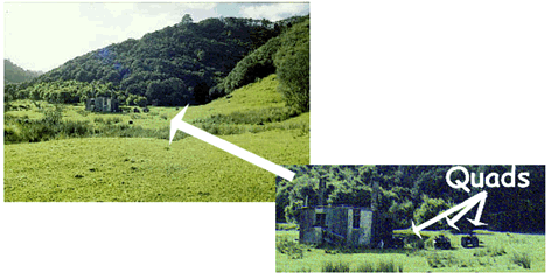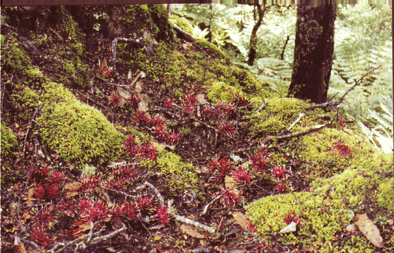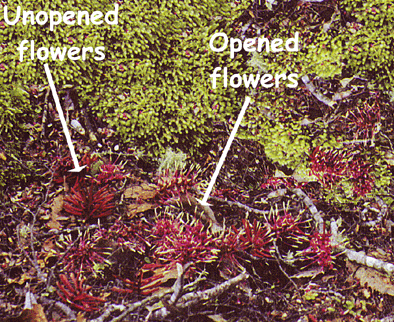



Press any of the buttons below to go to my other pages.
You are currently on a

page.
Disclaimer: these pages reflect my own personal opinions and do not necessarily reflect Department of Conservation policy or opinions

Tangarakau; the beasts and the birds
![]()
This was home for the duration of our stay in Tangarakau. A shack sitting in the middle of a paddock. A lot of the materials were salvaged from the old houses that dotted the valley. As far as backcountry huts go this one is quite luxurious, it has an old coal range with a wetback feeding into a hotwater cylinder, a sink and a clawfooted bath both with hot and cold taps.

The photo isn't great, I took it more to show the locality rather than the hut. This shack has two bedrooms and a separate bathroom, a living area and a covered porch with rotting floorboards. A swallow was nesting under the veranda eaves, starlings and a possum mother and Joey were nesting in the roof. The possums didn't last long with a hunter around. 
Possums do a great deal of damage in the bush. The rewarewa (Knigthia excelsa) flowered heavily this year. The possums greatly appreciate this, under every tree you find hundreds of flowers that have been broken or chewed off by possums.

In Auckland, where I was doing my PhD, intact flowers on the ground only happened in areas where there were possums, no raging storm could dislodge the flowers from the tree. Quite a few flowers we found at Tangarakau had possum chew marks on the bases. The flowers themselves look reasonably intact. You can't of course tell if all the nectar has been sucked out. Possums are known to eat leafbases of fivefinger (Pseudopanax arboreus) and nikau (Rhopalostylis sapida) flower bases without eating the leaves or flowers themselves. So, there is good reason to believe that they can be this destructive to rewarewa also. This picture of possum damage on fivefinger comes from the
Taihape reserve that I visited on September 20, 1998.
There were heaps of possums at Tangarakau. One of the things we did was a lizard and gecko survey. So, in the morning, TH and DC would wander around the area looking at nice sunny spots for reptiles basking in the sun (note that we don't have any snakes in New Zealand, not even in Zoos!). However, many our reptilian friends are nocturnal, so we also looked for them at night using strong spotlights and binoculars. You stand on a hill, shine the torch, preferably worn as a headlamp, at likely gecko habitat, and use the binoculars to spot the glint in their eye. DC is especially good at this, he can distinguish between the glint of a spider's eyes and that of geckos. I think spiders and insects gleam green and geckos red. We never found any geckos or lizards at all on this survey, so I can't tell you this from experience.
However, while out looking for geckos I noticed that the bushes were literally crawling with possums. You could hear them shake and rattle the trees and bushes all around as they hunted for food. On one night walk we saw no less than 16 possums, sitting stupidly halfway up trees blinking at our flashlights, in an hour's walk and heard many more. DC, with no effort at all, potted at least 30 of the beggars in an hour, all within cooey of the hut.
 You gotta to admire possums though, the barberry (Berberis glaucocarpa), which is a major weed in the valley, had new shoots and ripening fruit on it. A lot of the possums around the hut were climbing and eating in barberry, DESPITE the viscious spines, which are mean enough to puncture quad tires, let alone poke through delicate skin.
You gotta to admire possums though, the barberry (Berberis glaucocarpa), which is a major weed in the valley, had new shoots and ripening fruit on it. A lot of the possums around the hut were climbing and eating in barberry, DESPITE the viscious spines, which are mean enough to puncture quad tires, let alone poke through delicate skin.
At dusk, we looked for bats. We saw three longtailed bats over two nights, probably just a total of two bats, one seen twice. They are quite neat beasties. (more about bats).) Regenerating manuka scrub is very good kiwi habitat, so we listened for kiwi calling and looked for probes. We heard one on the last night and DC only saw three probe marks, we expected more than that.
During the day, we would go off on forays to find birds and interesting insects. I met my first tomtits, cute black and white birds, and between us we probably heard or saw 20+ bird species. DC had a kokako tape with him and we would play this at intervals in the hopes that any resident kokako might call back. None did. Insect life was reasonably scarce too, I only saw two weta. I'm not surprised given the numbers of possums.
 The boys also spend time fishing for eels and other native fish. They caught some bullies (little fish with big heads, a very appropriate name I think) in these small funnel nets, but the eels eluded them. I think DC did see a short-jawed kokopu, which are relatively rare, and some eels but not much more.
The boys also spend time fishing for eels and other native fish. They caught some bullies (little fish with big heads, a very appropriate name I think) in these small funnel nets, but the eels eluded them. I think DC did see a short-jawed kokopu, which are relatively rare, and some eels but not much more.
Therefore, sadly to say, this part of Tangarakau Conservation Area is very degraded, and we have lost many animal species. The plants don't fare too much better, but I did have fun. Tell you about that next time.
Back to the diary index | More about me | More about my PhD | Other adventures
This page hosted by ![]() Get your own Free Home Page
Get your own Free Home Page